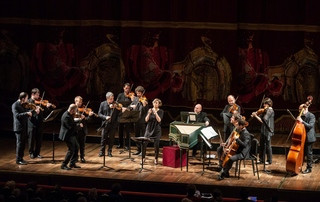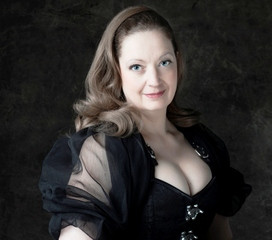|
Back
An Emotional Thesaurus New York
Zandel Hall, Carnegie Hall
02/27/2020 - & February 25 (Charlottesville), 28 (Boston), March 5 (Champaign), 2020
Antonio Vivaldi: Sinfonia in B minor for Strings and Continuo, RV 168 – Concerto in D minor for two Violins, Strings and Continuo, RV 514 – “Gelido in ogni vena” from Il Farnace, RV 711 – “Armatae face” from Juditha Triumphans, RV 644 – Concerto in D Major for Strings and Continuo, RV 121 – Concerto in C Major for Strings and Continuo, RV 114
George Frideric Handel: “Dopo l’orrore” & “Vieni, o figlio” from Ottone, HWV 15 – “Crude furie” from Serse – “Scherza infida” from Ariodante, HWV 33
Pietro Torri: “Quando il flebile usignodo” from L’Ippolito
Riccardo Broschi: “Son qual nave ch’agitata” from Artaserse
Ann Hallenberg (Mezzo-Soprano)
Venice Baroque Orchestra, Gianpiero Zanocco (Concertmaster and leader)

Venice Baroque Orchestra (© Courtesy of the Artists)
“Handel, the inspired master of our art.” Christoph von Gluck
“Handel, to him I bow the knee.”
Ludwig van Beethoven
“To gain the full flavor of a Vivaldi concerto, it is probably not enough to listen to even the most aggressive performance. One must imagine an equally aggressive audience–a house full of shouting, clapping stamping listeners...”
Richard Taruskin, Music in the Seventeenth and Eighteenth Centuries
Three laughable conceptions from my youth: 1. Mahler and Bruckner were two sides of the same coin; 2. Franz Liszt was banal, clamorous, and usually both; 3. Antonio Vivaldi composed one nice quartet of concertos about the seasons, with eight-hundred variations on the same piece.
The first two notions were long ago discounted. Yet only recently has the genius of Vivaldi–a seemingly endless genius both orchestral and vocal–been uncovered, dusted off and recorded. Cecilia Bartoli’s all-Vivaldi recording was like an archeologist digging up a lost temple, and in effect radiating the Baroque universe.
Yet almost simultaneously, the great Swedish mezzo, Ann Hallenberg, the soloist last night at Carnegie Hall–revealed more gems from Vivaldi, including whole operas never before performed.
Ms. Hallenberg could easily have devoted a whole evening to Vivaldi. In fact, during the last concert in New York, they devoted an entire evening to the composer’s masterpiece, Juditha Triumphans.
That one included trumpets, drums, clarinets and blazing emotions. Last night, they reduced their forces considerably. A half-dozen violins, a pair of violas and cellos, a bass, a harpsichord, lute and bassoon. But here they had an equal challenge. Namely, to show all of the emotions–the raging, vexations, love, adoration, temperaments and prayer–of the Italian Baroque age.
(Including, of course, the Saxon/Londoner G.F. Handel.)
As the geographical/spiritual home of Vivaldi, the orchestral portions were devoted to him, and one could spot all those aggressive, pyrotechnical string sections to the “Red Priest”. Yet nowhere, except in the vocal aria from Farnace did one hear quotes (or, in our generation, “memes”) from Seasons.
Rather, one heard four different Vivaldi styles. The opening Sinfonia, an alternative name for “concerto”, was your usual rushing, mad–and lovely slow movement)–Vivaldi. The two-violin Concerto, a form which Bach loved and imitated, employed both Concertmaster Gianpiero Zanocco and Mauro Spinazzè.
My own favorite was the RV 121 Concerto, where lutenist Ivano Zanenghi lent that so-lovely Italianate nocturnal strumming. Finally was a two-movement Concerto ending with a delicious chaconne including bassoon solos.

A. Hallenberg (© Orjan Jakobsson)
To the audience, though, sinuous, melodic and warm as the Venice Baroque Orchestra was, Ann Hallenberg wasa favorite. The program called her “The Swedish Nightingale”, in deference to Jenny Lind, the first renowned opera singer in America. That was unfair: Lind was a soprano, not a mezzo. And her fame was due to P.T. Barnum, not her own voice, which apparently was far from the most stellar.
Ms. Hallenberg, as the age of 56, has more than a mezzo’s command. She is dramatic, she can be impatient (at times she wanted to the Orchestra to accelerate), and she has endless projecting skill.
Not especially in the opening Handel aria, where she barely was heard above the accompaniment. But in an aria from one Pietro Torri, the ensemble was pruned down to a single violin and a few other instruments. Here, in a poem about nightingales, both she and Mr. Zanocco trilled and warbled avian style.
Nowhere did Ms. Hallenberg take advantage of the bel canto runs which distinguished her 18th Century predecessors. Her variations were modest, relying on the original composing–as in a low-to-high scale including all the sharps and flats in one Vivaldi aria.
Yes, the final work by Riccardo Broschi was a show-stopper, and yes, the other arias, from Vivaldi and from Handel’s Ottone gave vent to blood-curdling anguish and gorgeous soothing melody.
These, and two encores (including the famous one from Rinaldo) showed a singer who–again, unlike her forebears–was an artist whose eloquence, whose tonal mastery and respect for the written note was more important than showing off her instrument.
Was it Rossini who once told a soprano, “I believe I heard one of my notes when you sung my song”? With Ms. Hallenberg, we heard all the notes, and all the clarity.
She and the Venice Baroque Orchestra produced a beauty in Handel’s Vieni, o figlio which could have been composed by Gluck or Mendelssohn. And in Vivaldi’s Juditha Triumphans music which was violent, almost savage.
What we heard then last night was more than a great mezzo and a splendid period-instrument ensemble. We heard an era which had quarantined that Lutheran Bach, to allow the sunshine pleasures of the Mediterranean to erupt in all its pagan splendor.
Harry Rolnick
|